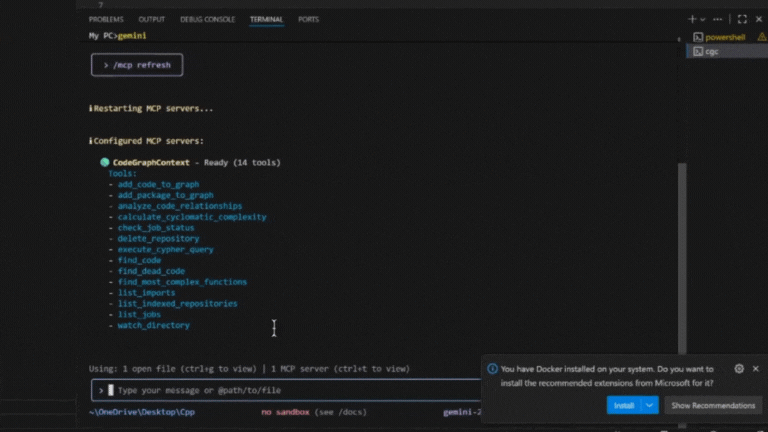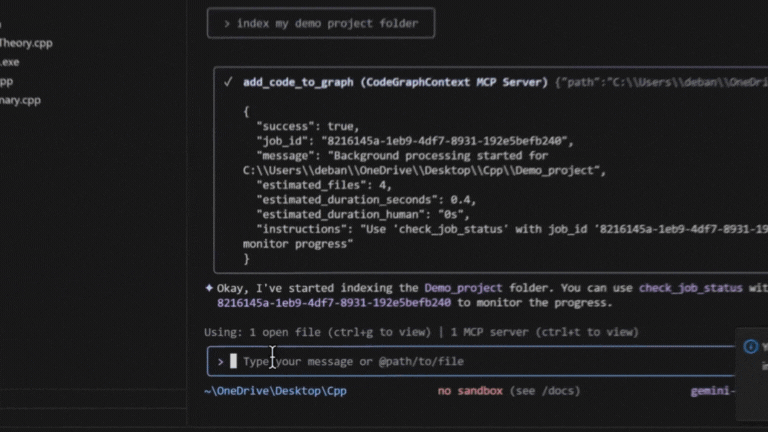CodeGraphContext
An MCP server that indexes local code into a graph database to provide context to AI assistants.
Indexing a codebase

Using the MCP server

Project Details
- Version: 0.1.11
- Authors: Shashank Shekhar Singh shashankshekharsingh1205@gmail.com
- License: MIT License (See LICENSE for details)
- Website: CodeGraphContext
Features
- Code Indexing: Analyzes Python code and builds a knowledge graph of its components.
- Relationship Analysis: Query for callers, callees, class hierarchies, and more.
- Live Updates: Watches local files for changes and automatically updates the graph.
- Interactive Setup: A user-friendly command-line wizard for easy setup.
Used By
CodeGraphContext is already being explored by developers and projects for:
- Static code analysis in AI assistants
- Graph-based visualization of Python projects
- Dead code and complexity detection
If you’re using CodeGraphContext in your project, feel free to open a PR and add it here! 🚀
Dependencies
neo4j>=5.15.0watchdog>=3.0.0requests>=2.31.0stdlibs>=2023.11.18typer[all]>=0.9.0rich>=13.7.0inquirerpy>=0.3.4python-dotenv>=1.0.0
Getting Started
- Install:
pip install codegraphcontext - Setup:
cgc setupThis interactive command guides you through configuring your Neo4j database connection and automatically setting up your IDE. Database Configuration:- Local Setup (Docker Recommended): Helps you set up a local Neo4j instance using Docker. Requires Docker and Docker Compose to be installed.
- Local Setup (Linux Binary): For Debian-based Linux systems (like Ubuntu),
cgc setupcan automate the installation of Neo4j. Requiressudoprivileges. - Hosted Setup: Allows you to connect to an existing remote Neo4j database (e.g., Neo4j AuraDB).
IDE/CLI Configuration: After setting up your database, the wizard will ask to configure your development environment. It can automatically detect and configure the following:
- VS Code
- Cursor
- Claude
- Gemini CLI
Upon successful configuration,
cgc setupwill generate and place the necessary configuration files:- It creates an
mcp.jsonfile in your current directory for reference. - It stores your Neo4j credentials securely in
~/.codegraphcontext/.env. - It updates the settings file of your chosen IDE/CLI (e.g.,
.claude.jsonor VS Code'ssettings.json).
- Start:
cgc start
MCP Client Configuration
The cgc setup command attempts to automatically configure your IDE/CLI. If you choose not to use the automatic setup, or if your tool is not supported, you can configure it manually.
Add the following server configuration to your client's settings file (e.g., VS Code's settings.json or .claude.json):
Natural Language Interaction Examples
Once the server is running, you can interact with it through your AI assistant using plain English. Here are some examples of what you can say:
Indexing and Watching Files
- To index a new project:
- "Please index the code in the
/path/to/my-projectdirectory." OR - "Add the project at
~/dev/my-other-projectto the code graph."
- "Please index the code in the
- To start watching a directory for live changes:
- "Watch the
/path/to/my-active-projectdirectory for changes." OR - "Keep the code graph updated for the project I'm working on at
~/dev/main-app."
When you ask to watch a directory, the system performs two actions at once:
- It kicks off a full scan to index all the code in that directory. This process runs in the background, and you'll receive a
job_idto track its progress. - It begins watching the directory for any file changes to keep the graph updated in real-time.
This means you can start by simply telling the system to watch a directory, and it will handle both the initial indexing and the continuous updates automatically.
- "Watch the
Querying and Understanding Code
- Finding where code is defined:
- "Where is the
process_paymentfunction?" - "Find the
Userclass for me." - "Show me any code related to 'database connection'."
- "Where is the
- Analyzing relationships and impact:
- "What other functions call the
get_user_by_idfunction?" - "If I change the
calculate_taxfunction, what other parts of the code will be affected?" - "Show me the inheritance hierarchy for the
BaseControllerclass." - "What methods does the
Orderclass have?"
- "What other functions call the
- Exploring dependencies:
- "Which files import the
requestslibrary?" - "Find all implementations of the
rendermethod."
- "Which files import the
- Advanced Call Chain and Dependency Tracking (Spanning Hundreds of Files):
The CodeGraphContext excels at tracing complex execution flows and dependencies across vast codebases. Leveraging the power of graph databases, it can identify direct and indirect callers and callees, even when a function is called through multiple layers of abstraction or across numerous files. This is invaluable for:
- Impact Analysis: Understand the full ripple effect of a change to a core function.
- Debugging: Trace the path of execution from an entry point to a specific bug.
- Code Comprehension: Grasp how different parts of a large system interact.
- "Show me the full call chain from the
mainfunction toprocess_data." - "Find all functions that directly or indirectly call
validate_input." - "What are all the functions that
initialize_systemeventually calls?" - "Trace the dependencies of the
DatabaseManagermodule."
- Code Quality and Maintenance:
- "Is there any dead or unused code in this project?"
- "Calculate the cyclomatic complexity of the
process_datafunction insrc/utils.py." - "Find the 5 most complex functions in the codebase."
- Repository Management:
- "List all currently indexed repositories."
- "Delete the indexed repository at
/path/to/old-project."
Contributing
Contributions are welcome! 🎉
Please see our CONTRIBUTING.md for detailed guidelines.
If you have ideas for new features, integrations, or improvements, open an issue or submit a PR.
Join discussions and help shape the future of CodeGraphContext.
This server cannot be installed
local-only server
The server can only run on the client's local machine because it depends on local resources.
Indexes local Python code into a Neo4j graph database to provide AI assistants with deep code understanding and relationship analysis. Enables querying code structure, dependencies, and impact analysis through natural language interactions.
Related MCP Servers
- -securityFlicense-qualityA Python-based local indexing server that creates semantic search capabilities for codebases using ChromaDB, allowing Cursor IDE to perform vector searches on your code without sending data to external services.Last updated -24
- -securityFlicense-qualityAn implementation for managing Neo4j graph database operations through the Model Context Protocol, enabling users to execute Cypher queries against their Neo4j database via AI assistants like Cursor and Claude Desktop.Last updated -74
- -securityFlicense-qualityEnables storage and retrieval of knowledge in a graph database format, allowing users to create, update, search, and delete entities and relationships in a Neo4j-powered knowledge graph through natural language.Last updated -3
- -securityAlicense-qualityAn MCP server that transforms codebases into knowledge graphs using Neo4J, enabling AI assistants to understand code structure, relationships, and metrics for more context-aware assistance.Last updated -6MIT License